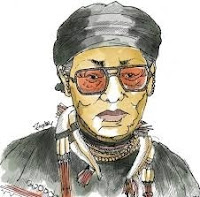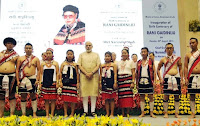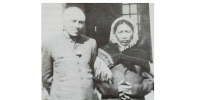VSK TN
“Any nation or country would be proud to have such a gifted woman who sacrificed everything for her people and for the cause she believed was good and true. She became a living legend in her own lifetime”- An Indian historian
Like other freedom fighters, her role in Indian freedom struggle and sacrifice for the nation did not get much attention in the country. A National Committee to celebrate birth centenary of Rani Maa Gaidinliu was formally constituted in Guhawati on 4th May, 2014 to organise programmes throughout the country to throw light on various aspects of freedom movement and religious awakening undertaken by Rani Gaidinliu.
Gaidinliu challenged the mighty British at very young age by preaching to ethnic Naga communities from remote hills of North-East – “We, Nagas were and are free people, the white, the British have no right to rule over us, so we should not recognize their sovereignty over us and will not pay house tax to the British Government and unjust laws like forced labour and compulsory porter subscription” Because of this, British Parliament described her as “terror of North East”.
During inauguration of her birth centenary celebrations on 24th August, 2015, Prime Minister, Sh. Narendra Modi highly praised her for fighting against the British colonialism and emphasised that her struggle for the Naga people against the British, was a part of struggle for Bharat’s unity and integrity.
Inaugration of Birth Centenary Celebrations of Rani Gaidinliu om 24th August, 2015 by Hon’ble Prime Minister Sh. Narendra Modi.
Former Prime Minister Atal Behari Vajpayee also described Rani Gaidinliu as a great freedom fighter of India.
Let us all remember Rani Gaidinliu, the lone freedom fighter who spent the longest years in jail (from 1933 to 1947), for her indomitable spirit and for the freedom that she fought for so valiantly. Rani Gaidinliu joined the Indian freedom struggle at the age 13. At 16, this brave girl was sentenced to life imprisonment for leading a movement to drive out the Britishers from Manipur and Nagaland. She was released from the jail in 1947 after Bharat’s independence.
Early life:
She was born on January 26, 1915 at Nungkao, a Rongmei village (in the present-day Tousem sub-division of Tamenglong District) in western part of then colonial Manipur. She belonged to the Rongmei community, one of the three Zeliangrong communities. Brought up in a socially backward region, Gaidinliu could never receive any formal education. However, this did not stop her from joining the freedom struggle.
Struggle period:
Gaidinliu came under the influence of her cousin, Haipou Jadonang, at very young age,, who was then leading a socio-political movement called Heraka (meaning ‘pure’), seeking to drive out the British from the region. The movement took inspiration from ancestral Naga practices. He was able to gather strong support from various communities and emerged as a strong voice of opposition against the British in a span of six years. In February 1931, he was arrested, and was hanged on August 29, 1931 at Imphal jail after a mock trial by the British authorities.
With the death of Jadonang, the leadership of the Heraka movement fell upon Gaidinliu, who was barely 16 years old at that time. She asked her Zeliangrong communities-men to refuse to pay taxes and called out for freedom. She was assisted by donations from the local Naga community in her work against the British. She posed a huge threat to the colonial rule after getting support from majority of her people who refused to cooperate with the British.
Consequently, the British launched a manhunt to capture Gaidinliu, with a monetary reward going to anyone who volunteered shared reliable information. Despite these efforts by the authorities, she evaded arrest by moving across villages in the regions (present Assam, Nagaland, and Manipur) with her dedicated followers.
With growing dissent in the region, the British assigned a special troop of the Assam Rifles led by Captain MacDonald to arrest Gaidinliu. As soon as Captain MacDonald got a report of Gaidinliu and her followers being located in a village called Pulomi, he mounted a surprise attack by sending a large force in the opposite direction to mislead Gaidinliu. Perplexed by the raid on the village, Gaidinliu and her followers were captured without any resistance on October 17, 1932. Her trial went on for 10 months and she was convicted for murder and her attack on the Assam Rifles and was sentenced to life imprisonment. From 1933 to 1947, she served time at Guwahati, Shillong, Aizawl, and Tura jails.
On being appointed as the President of Indian National Congress in 1937, Jawaharlal Nehru undertook a tour in many parts of Assam to acquaint himself with the people and problems of the region. During the tour in Assam, he learnt about the Jadonang “Nagaraj Movement” and his execution by the British ruler and came to know about Gaidinliu’s and her imprisonment in Shillong jail.
Rani Gaidinliu was given the title of ‘Rani’ by the then-Prime Minister Pandit Jawaharlal Nehru.
Later, Nehru personally went to meet Gaidinliu in Shillong jail. On seeing her in the dark cell, he felt shock and highly praised her for her brave fighting against the mighty British rulers.
In an article carried by The Hindustan Times on 18 December 1937, Nehru wrote: “News of Gandhi and the Congress reached her and her hills abode… She dreamed of freedom for her people… and she raised the banner of independence and called her people to rally round it… India does not even know of this brave child of her hills…” He further wrote that a day would come when she would be released from her prison cell, and free India would remember and cherish her. Recognizing her heroic deed who dreamed of freedom, Nehru conferred the title of Queen or Rani of the Nagas and assured her that he would move the British Government to release her from the jail.
Having spent 14 years in various prisons, Rani Gaidinliu was released on Prime Minister Nehru’s orders from Tura jail in 1947 against the advice of Assam government. Thereafter, she was officially recognized as the legendary freedom fighter of India.
The Naga National Council under the leadership of A.Z. Phizo started a rebellion in 1956. The underground Naga leaders severely criticized the Rani Gaidinliu’s movement for integration of Zeliangrong communities under one administrative unit and considered this as a big obstacle to the Naga separatist movement as she was working for revival of the traditional religion of animism i.e., Heraka. Naga church leaders also targeted Gaidinliu’s revival movement of Heraka by terming it as anti-Christianity.
She went underground from 1960-66 to fight Phizo’s Naga National council. In response, she set up her own quasi-administration named the “Zeliangrong Government of Rani Party” of about 1000 men equipped with 400/500 rifles to defend her religion (Heraka), culture and to pressurize her demand for the single Zeliangrong Administrative unit.
The Government of India under Indira Gandhi clearly knew that her movement was not against Bharat as she was a nationalist. The State government of Nagaland and Manipur tried to persuade her to come overground and be a part of the mainstream.
The Government of Nagaland succeeded in persuading Rani Gaidinliu and her underground army to come over ground in January 1966. There-after, she stayed in Kohima from 1966 to 1992. Her underground army surrendered to Government of Nagaland and was inducted as a Battalion of Nagaland Armed Police.
Association with national organisations:
She was closely associated with national organisations like Vanvasi Kalyan Ashram, Vishwa Hindu parishad and Vidya Bharti. She met second RSS Chief MS Golwalkar at Jorhat in a Hindu conference in 1969. She attended 2nd World Hindu Conference from 26 January 24 to 26 1979 at Prayagraj (Allahabad). She toured the entire country. She informed the nation that neither all the Nagas were Christian nor they favoured separatism. She spread the message throughout the nation that majority of Nagas were Hindu and they wanted to live in Bharat.
She represented the state in national functions while staying in Nagaland. She was made the President of All India Freedom Fighters Association.
Award & Honors:
The Central government awarded her Freedom Fighter Tamrapatra in 1972 for her contribution in freedom struggle and her unparallel efforts in bringing Nagas into mainstream. She was conferred Padma Bhushan in 1981 and the Vivekananda Sewa Samman in 1983. In 1996, the Anthropological Survey of India posthumously awarded her the Birsa Munda Award. In the same year the Central government released a one-rupee postal stamp in her honour.
The Central government instituted Stree Shakti Puraskar in honour of five eminent women in the history of Bharat in 2000. Rani Gaidinliu was one of these five women. The Hindustan Shipyard Ltd also launched an in-shore patrol vessel name “Rani Gaidinliu” for the National Coast Guard at Visakhapatnam on 6th November, 2010. The Central government has also released coins in the denominations of Rs 100 and Rs 5 to commemorate the 100th birth anniversary of Rani Gaidinliu on 24th August, 2015.
Death and legacy:
All her political activities came to full stop after the occurrence of Kuki-Naga conflict in 1992. Moreover Rani Gaidinliu became sick and left Kohima and stayed thereafter in her native village with her family and relatives. After a brief illness, she breathed her last and left for her heavenly abode on 17th February 1993.
On the demise of Rani Gaidinliu, her people and whole nation including Shri Narasimha Rao, the then Prime Minister of India mourned. Her last rites were performed with full State Honour in the presence of Shri Chintamani Panigrahi, Governor of Manipur.
Rani Gaidinliu would always be remembered in the annals of history as the great nationalist brave freedom fighter of Bharat. Her life of struggle and her integrity marked her out as a great daughter of Bharat from whom we can all learn how to serve the nation selflessly.
(Dr. Soniya,Assistant Professor (Sanskrit),Hindu College, Delhi University)




